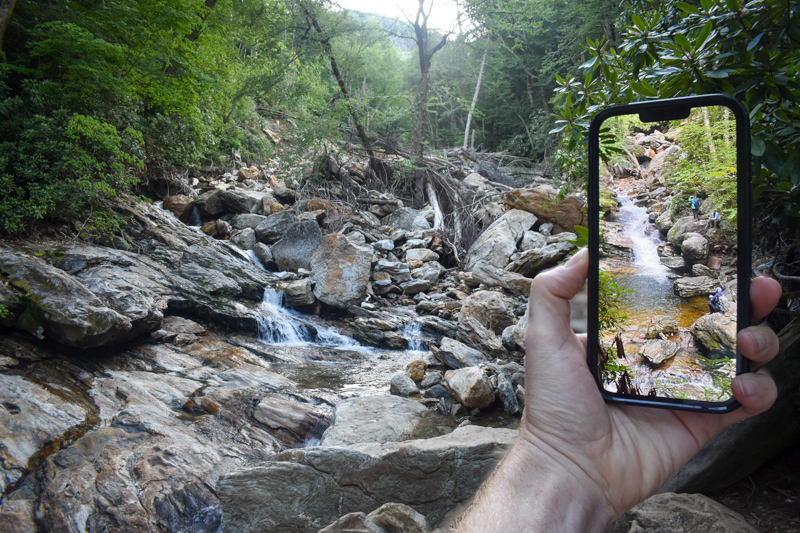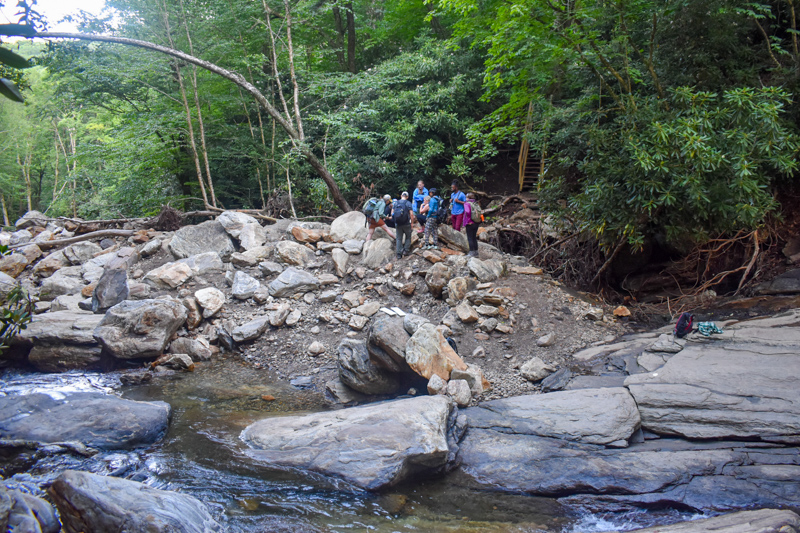Skinny Dip Falls — The Naked Truth
For immediate release ‐ August 30, 2022
Contact: Micah Beasley, 919.707.9970. Images available upon request
 What remains of Skinny Dip Falls, next to a cell phone photo of the falls as they existed before the tropical storm. Photo: Chris Smith.
What remains of Skinny Dip Falls, next to a cell phone photo of the falls as they existed before the tropical storm. Photo: Chris Smith.
By Chris Smith, Coordinator of Current Science Programs
Picture in your mind the most pristine mountain waterfall you can imagine. Now, imagine a giant bulldozer driving down the middle of that river, moving boulders, trees, and nearly flattening the falls. Skinny Dip Falls on the Blue Ridge Parkway experienced such a fate when a tropical storm brought heavy rains and massive flooding.
I first visited the Falls in 2021 as a coleader of the first Educators of Excellence Blue Ridge Institute led by Melissa Dowland and Megan Davis. The hike to the falls was easy, the forest tranquil, and the waterfall was glistening. I spent the time sitting on a walking bridge taking photos and scrambling around boulders. Just days after our group departed the Parkway, a tropical storm remnant brought heavy rain and flooding to the mountains. Skinny Dip Falls washed away.
When I was invited to go again this past July, I couldn’t pass it up. The experience for these teachers is well crafted. There are activities that require you to push past your comfort zones, but you never feel unsafe. For example, you can have your head held underneath a cold, mountain river so you can catch a glimpse of a hellbender. The Institute is experiential education at its best. I also wanted to see Skinny Dip Falls again.
My jaw dropped as we rounded the trail and the falls came into view. It was gone. The boulders were scattered, the banks washed away, and the trees and rhododendron that shaded the water were in piles along the rocks.
 The group at Skinny Dip Falls, as rearranged by a tropical storm. Photo: Chris Smith.
The group at Skinny Dip Falls, as rearranged by a tropical storm. Photo: Chris Smith.
Local news in Western North Carolina had shared the dramatic change, so Melissa had suggested an activity where teachers analyze major flooding events and associations with global climate changes. Co-leader Greg Skupien prepared thorough discussion questions, data of major storm events, and photos of the falls. We sat on the edge of the falls and had a long conversation with the teachers about the impacts of climate change; how our understanding of these events and their association to climate change is, itself, changing; our responsibility as individuals, educators, and members of our communities is to promote solutions.
The natural and cultural history of the Blue Ridge Mountains is one of changes, from the massive geologic events that first formed the Appalachians to the advance of European settlers clearing land to the uncertain ways climate change will impact the region. The Institute connects our state’s educators to these stories in order to pass them on and to inspire current and future generations. I’m grateful for the opportunity to be a part of that.
For more information about our upcoming activities, conservation news and ground-breaking research, follow @NaturalSciences on Instagram, Twitter and Facebook. Join the conversation with #visitNCMNS.

